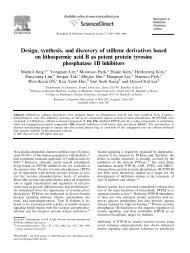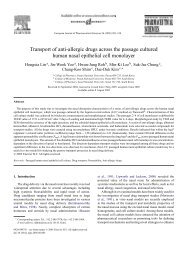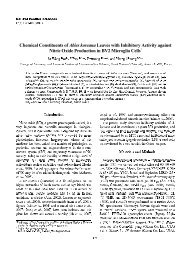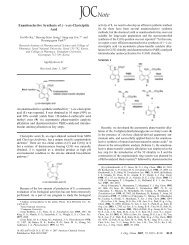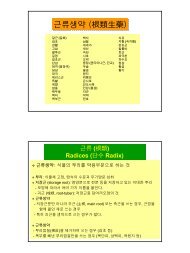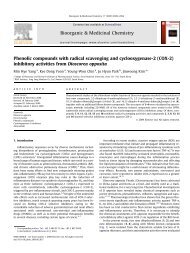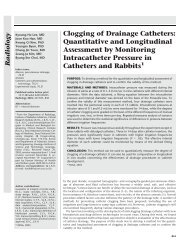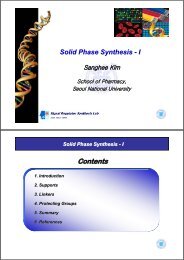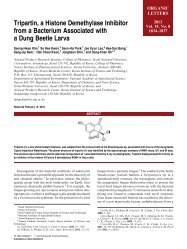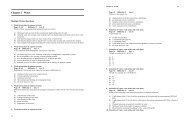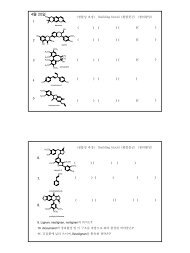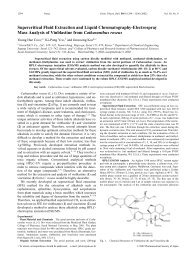Bioorganic & Medicinal Chemistry Letters
Bioorganic & Medicinal Chemistry Letters
Bioorganic & Medicinal Chemistry Letters
You also want an ePaper? Increase the reach of your titles
YUMPU automatically turns print PDFs into web optimized ePapers that Google loves.
3812 H. J. Kim et al. / Bioorg. Med. Chem. Lett. 21 (2011) 3809–3812Figure 4. Effects of compound 5f on the change of blood glucose levels in C57BL/6 mice after oral glucose loading. Data were presented as means ± SEM.Table 4Preliminary pharmacological and kinetic data of compound 5fCYP450, 3A4/2D6/2C9/2C19/1A2>50 lMHuman liver microsome t 1/2>90 mint 1/2 (rat)6.10 hCL (rat)60.5 mL/min/kgV ss (rat)12.0 L/kgForal (rat) 74.8%hERG, patch clamp IC 5079.6 lMIn a separated experiment, compound 5f was evaluated usingoral glucose tolerance test (OGTT) in the C57BL/6J mice. 17 Compound5f (0.1, 0.3 or 1.0 mg/kg) significantly inhibited the elevationof blood glucose and reduced the glucose AUC in dosagedependentmanner achieving maximal efficacy at 1 mg/kg, with63% inhibition (Fig. 4).Compound 5f was submitted to the advanced test includingpreliminary experiments on pharmacokinetic parameters in rats(Table 4). Additionally, compound 5f was applied for a panel ofreceptors and enzymes and it showed no known liabilities at testconcentrations of 1 lM. 18In conclusion, we have shown that variations of b-amino amidecontaining the piperazine-2-one scaffold used in the clinical developmentcompound 5f (DA-1229), which retains excellent DPP-4inhibitory activity, in vivo efficacy and preliminary safety profiles,as well as subtype selectivity. 19 DA-1229 is currently undergoingphase II clinical trials and holds the potential for once-daily treatmentof type 2 diabetics.References1. Nathan, D. M.; Buse, J. B.; Davidson, M. B.; Ferrannini, E.; Holman, R. R.;Sherwin, R.; Zinman, B. Diabetes Care 2009, 32, 193.2. DeFronzo, R. A. Diabetes 2009, 58, 773.3. Knudsen, L. B. J. Med. Chem. 2004, 47, 4128.4. Murphy, K. G.; Dhillo, W. S.; Bloom, S. R. Endocr. Rev. 2006, 27, 719.5. For recent reviews, see: (a) Mest, H.-J.; Mentlein, R. Diabetologia 2005, 48, 616;(b) Weber, A. E. J. Med. Chem. 2004, 47, 4135; (c) Drucker, D. J. Expert Opin.Invest. Drugs 2003, 12, 87; (d) Augustyns, K.; Van der Veken, P.; Senten, K.;Haemers, A. Expert Opin. Ther. Patents 2003, 13, 499.6. Villhauer, E. B.; Coppola, G. M.; Hughes, T. E. Annu. Rep. Med. Chem. 2001, 36,191.7. Drucker, D. J.; Nauck, M. A. Lancet 2006, 368, 1696.8. Ahren, B. Expert Opin. Emerg. Drugs 2008, 13, 593.9. Pei, Z. Curr. Opin. Drug Disc. Dev. 2008, 11, 512.10. Gwaltney, S. L., II Curr. Top. Med. Chem. 2008, 8, 1545.11. Xu, J. et al Bioorg. Med. Chem. Lett. 2004, 14, 4763.12. Brockunier, L. L. et al Bioorg. Med. Chem. Lett. 2004, 14, 4759.13. Oefner, C.; D’Arcy, A.; Sweeney, A. M. Acta Crystallogr., Sect. D 2003, 59,1206.14. Kim, D.; Wang, L.; Beconi, M. J. Med. Chem. 2005, 48, 141.15. DPP-4 inhibition assay: Inhibitors at various concentrations were incubatedwith 20 ng/ml rhDPP-4 enzyme and 50 lM H-Gly-Pro-AMC for 1 h at 25 °C. Thefluorescence (360 nm excitation/465 nm emission) was measured after 1 h.16. Aertgeerts, K.; Ye, S.; Tennant, M. G. Protein Sci. 2004, 13, 412.17. Compound 5f or vehicle (0.5% methylcellulose) was treated orally and thenchallenged with glucose (2 g/kg) 30 min post-dose. The blood glucoseexcursion profile from 0 to 120 min was used to integrate an area under forcurve (AUC) and percent inhibition values for each treatment were generatedfrom the AUC data normalized to the non-glucose controls.18. Off target selectivity was screened by MDS pharm service pharmacologypackages: LeadProfilingScreen Ò , EnzymeProfilingScreen Ò .19. Kim, H. J.; Kim, H. D.; Kwak, W. Y. Diabetes 2008, 57. 2611-PO.



